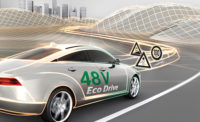In the early days of air transport, pilots relied on a nationwide network of beacons for night time navigation. A hundred years later, the first generation of autonomous vehicles may also rely on light beams to navigate safely.
One of the companies leading the way toward the driverless future is Valeo, an automotive technology company based in France that produces a wide variety of components ranging from ultrasonic sensors to lidar systems. The company has already achieved a number of breakthroughs in the field of intuitive driving, including 24 hours on the Paris beltway, as well as road trips around Europe and the United States.
“Exterior lighting innovations will play a key role in autonomous driving and future mobility systems,” says James Schwyn, chief technical officer at Valeo North America Inc. “These LED-based systems will help vehicles communicate with and warn other vehicles or pedestrians.
“Autonomous cars are fueling the need for vehicles to communicate with human drivers of other vehicles using non-verbal, easy-to-understand messages,” adds Schwyn. “We are helping make this possible with a series of new exterior lighting systems that can do everything from projecting information on the ground to displaying text or logos on tail lights.”
At the recent Paris Motor Show, Valeo unveiled several innovations, including high-definition forward lighting and kinetic rear lighting.
“With these two revolutionary technologies, vehicles driving in automated mode can communicate with the surrounding environment using their headlamps and rear lights,” claims Schwyn. “Projecting or displaying images in a variety of situations will improve safety.”
High-definition lighting projects customized images or messages onto the road in front of a vehicle by altering the shape of the light beam. For instance, it can project information such as directions from a GPS navigation system or warning messages when the vehicle’s sensors detect a potential danger in automated driving mode.
Kinetic rear lights communicate with the surrounding environment by displaying pictograms or personalized messages. A car in automated driving mode equipped with a kinetic system can inform a vehicle behind it whenever its sensors detect a hazardous situation, such as a pedestrian who’s about to cross the road. It can also warn drivers following behind that the vehicle is operating in autonomous mode or is about to make a stop.
In addition, kinetic technology can be used to personalize vehicles. For example, motorists could choose a scenario that plays out when they unlock their car or open their doors, such as some sort of rear lighting effect, by selecting a pictogram or a predefined moving pattern.
“We’re transitioning from lighting as an illuminating feature to lighting as an interface that improves communication around a vehicle as it’s moving,” says Schwyn. “Autonomous vehicle lights could look much different than they do today. The main difference will be what’s packaged inside the headlight.
“Our technology uses the dense matrix of LEDs to change the shape of light beams.” Schwyn points out. “We create a grid with pixels. Software turns each LED on or off, depending on the message that’s required.
“The more pixels you have, the finer and more discrete the imaging is,” notes Schwyn. “One LED is basically the on or off function. Ten LEDs allow us to create a moving light beam; 100 LEDs enable us to start making shapes; and 1 million LEDs let us make a precise picture.
“This technology is currently in development mode with automakers,” says Schwyn. “But, we expect to see it commercially available in the coming years.”




